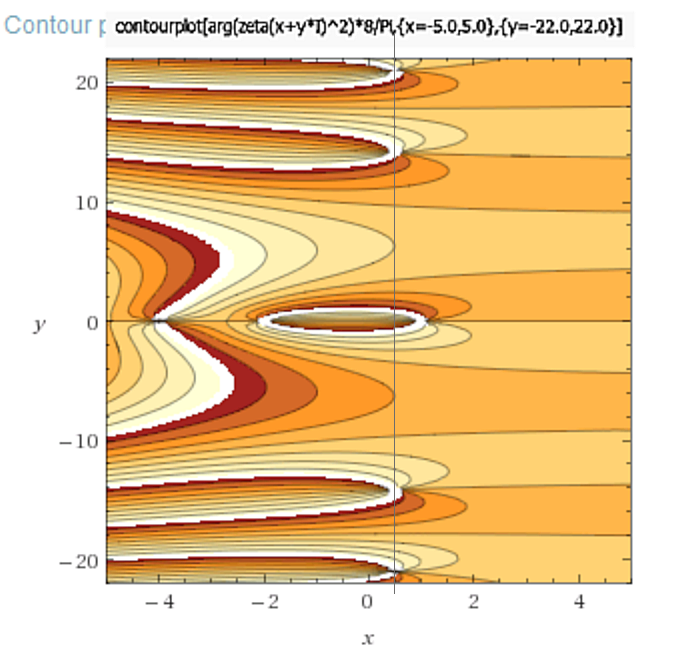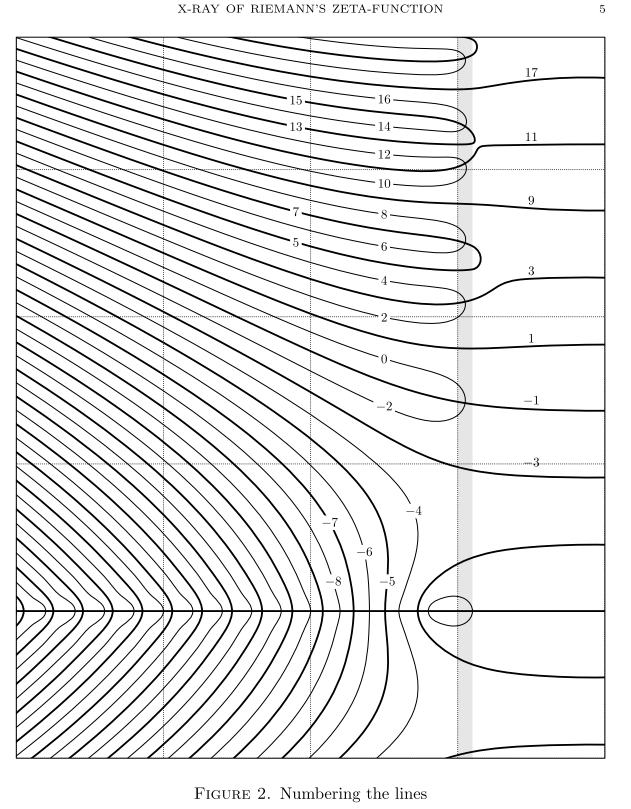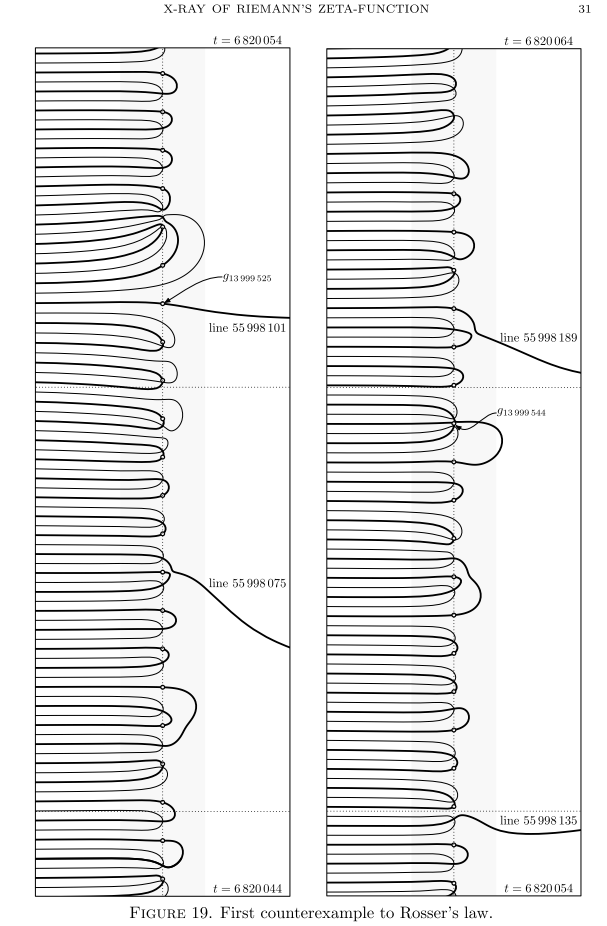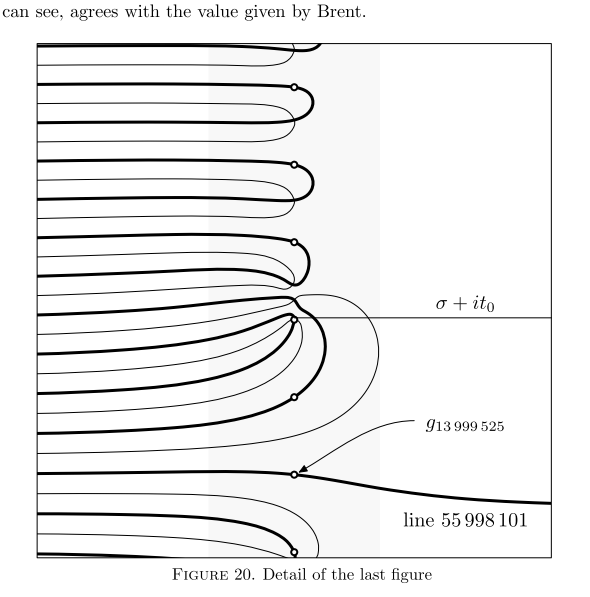(This is an extension and specification of a question which I initially asked in MSE having now one comment (which I could not yet digest completely) and which I also detailed further (after working on it much) so that I think this is a better place here)
Initially out of idle curiosity I considered whether on a (small) circle with radius $|\varepsilon|$ around a nontrivial root (where $\zeta(\rho)=0 + î0$) is also a point with $\zeta(\rho+\varepsilon)=a + îa$ with some $a$ - with the simple background that the same condition (the real part is equal to the imaginary part) holds also on the root.
In extension of this I speculated, whether there might be even continuous lines of arguments $\rho + \varepsilon$ with increasing distance to $\rho$, all with the same ratio of the real to the imaginary part of the zeta at this points; and that those lines ("isogones" or "isogonals") should cross the root because the real and imaginary part both being zero is compatible with any proportion/ratio.
In MSE Daniel Fischer gave an initial small comment that such lines actually exist, but I'm now interested in a more intuitive and possibly more general argument for the basic idea and then for the generalizations of the subsequent observations which I've seen when I played with this problem numerically.
Assume a circle with small radius $r$ around some zero of the zeta. Let $w_\varphi$ denote some point on this circle:
Q1: Is it true that with complex coordinates $w_\varphi$ from that circle we'll find $\operatorname{arg}(\zeta(w))$ covering the full interval $0..2\pi$ ?
Q2: If we continuously increase $r$ from $0+\delta$ , do we find continuous lines (isogonals) for the loci of the values $w_{\varphi_r}$ where all $\operatorname{arg}(\zeta(w_{\varphi_r})))$ are equal? (I've seen, that crossing the root the arg() adds one $\pi$, but that's not important here, because we can discuss this in terms of the ratio of the real and the imaginary part) ?
Here is an image where I draw some example lines with isogonal $\zeta()$-values in steps of $\pi/16$.

The light blue isogone with $\pi/4$ has zeta-values where real and imaginary parts are equal and illustrates the hypothetical interpolation of my initial question.
The isogone with arg$(\zeta(w))=0$ could not be drawn (didn't yet investigate the reasons, it seems the Newton-rootfinding or the iterative tracing algorithm did not nicely converge)
By the dots on the curves one can see the increase of the radius of the circles around $\rho$ in steps of $0.1$ up to $2.5$ or so. On each circle we see the full set of isogones crossing.
(I've just found, that J. Stopple has discussed the zeta with focus on the arg$(\zeta())$ aspect in some articles, and has provided a small extract of his book online with a related picture, but the contourlines for the same arg()s are not well discernible.)
The questions seem to have an interesting aspect, so I'd like to be able to formalize also the shape of the net of the lines.
Assume beyond the answer of the two above questions: that this properties of the curves are also a constitutive property of the roots of the zeta, and that this curves cannot be somehow degenerate, then it seems that the assumption of two separate roots symmetric to the critical lines would lead to contradictory sets of isogones which would cross each other requiring two different arg() of the zeta at the same argument $w$.
So it seems, that the shape of the net of isogones is critical for the question of two symmetric roots aside the critical line (and unfortunately its formal description should then be of similar difficulty as the answering of the RH itself...)
[update 2]
Here is an image showing some isogones of the zeta at the first two complex roots, and symmetric around the real axis (so we see also an indication of the near of $\zeta(1)$.
The appearance of the image is somehow arbitrary, it is a contourplot using W/A with the command $\small \arg(\zeta(x+y \cdot î )^2$ where I used the squared of the complex zeta-value to get the colors of the contourplot better organized. Unfortunately I have no control to indicate the level of the contourlines (=isogones), and because it seems, W/A uses 8 levels by default I rescaled to have finally $\small \arg(\zeta(x+y \cdot î )^2)*8/\pi $

This image makes my first (odd) speculation a bit more precise: there seem always to exist isogones passing the nontrivial root and escaping to infinity at the positive real side with a continuum of neighboured isogones. If that is constitutive for any root of the zeta then I cannot imagine how two nontrivial roots symmetric about the critical line could exist without contradicting measures by the crossings of the according isogones in the area around such assumed roots.



